Mushrooms
Media
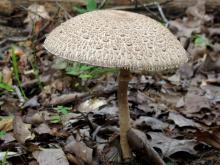
Species Types
Scientific Name
Macrolepiota procera (Lepiota procera)
Description
The parasol is very tall, with a cap that is buff to brown, broad, scaly, with a knob in center; there is a moveable ring on stalk. It grows scattered on the ground, along trails, in open woods, and in old pastures.
Media
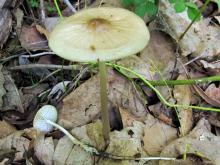
Species Types
Scientific Name
Xerula furfuracea (Collybia radicata var. furfuracea)
Description
The rooted collybia has a moist, wrinkled, grayish brown flat cap and a long, slender stalk that continues underground. It grows singly or scattered on and around deciduous trees and stumps.
Media
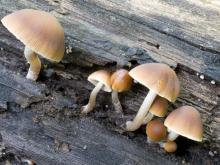
Species Types
Scientific Name
Various species of confusingly similar mushrooms
Description
Like the LGBs (“little gray birds”) of the birdwatchers, this is a catchall category. It includes all the small to medium-sized, hard-to-identify brownish mushroom with spores of all colors. There are many hundreds of species that fit this description!
Media
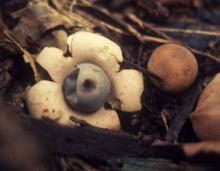
Species Types
Scientific Name
Geastrum species
Description
An earthstar is a roundish ball in the center of starlike rays. It grows on the ground in open woods.
Media

Species Types
Scientific Name
Meripilus sumstinei (formerly M. giganteus)
Description
The black-staining polypore grows in large, circular clusters of many fleshy, grayish yellow, fan-shaped caps, which bruise black when cut or touched. It grows on the ground around deciduous trees, especially oaks.
Media
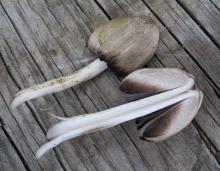
Species Types
Scientific Name
Coprinopsis atramentaria (formerly Coprinus atramentarius)
Description
The alcohol inky has a gray-brown, bell-shaped, radially lined cap and inky gills. It grows in clusters on the ground, usually near rotting or buried wood.
Media

Species Types
Scientific Name
Amanita spp. (about 600 species, worldwide)
Description
This large group of mushrooms accounts for 90 percent of mushroom-related deaths, so every mushroom hunter should be familiar with amanitas. They contain one of the deadliest poisons found in nature!
Media

Species Types
Scientific Name
Russula virescens
Description
Green cracking russula has a cap with a greenish, cracked, mosaic-like top, and cream-colored gills. It grows singly or in groups in mixed woods.
Media

Species Types
Scientific Name
Pluteus atricapillus (formerly P. cervinus)
Description
The fawn mushroom has a brownish gray cap with whitish to pinkish gills and a whitish stalk. It grows singly or scattered, on dead wood or on the ground over buried wood.
See Also



Media

Species Types
Scientific Name
Monotropa hypopitys
Description
Pinesap is a plant that puts the "wild" in wildflower! It lacks chlorophyll, so its roots connect to fungi underground and absorb nutrients from the fungi.
Media

Species Types
Scientific Name
Cladophora, Pithophora, and Spirogyra spp., and others
Description
Filamentous green algae forms green, cottony masses that are free-floating or attached to rocks, debris, or other plants.
Media

Species Types
Scientific Name
Monotropa uniflora
Description
Indian pipe lacks chlorophyll, so it is white, not green. Below ground, its roots join with fungi that connect to tree roots. This plant, then, takes nourishment indirectly from the trees.
About Mushrooms in Missouri
Mushrooms are a lot like plants, but they lack chlorophyll and have to take nutrients from other materials. Mushrooms are neither plants nor animals. They are in a different kingdom — the fungi. Fungi include the familiar mushroom-forming species, plus the yeasts, molds, smuts, and rusts.
Always be cautious when eating edible mushrooms. Be absolutely sure of the ID, and only eat a small amount the first time you try it to avoid a reaction..





















